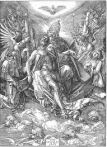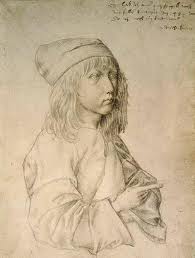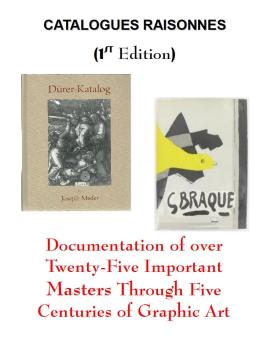I would like to think that the value of Durerpost products and information are self-evident; and they will, eventually promote themselves. But until then, forgive me for giving them a little impetus forward.
Recently at auction (March, to be exact), an Albrecht Durer woodcut, the Annunciation (M. 195, B. 83) from one of his great woodcut cycles, the Life of a Virgin, was sold at auction for just under $11,000. It was sold as a proof impression before the Latin Text Edition of 1511 with a High Crown watermark (M. 20).
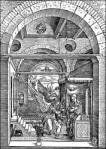
The catalogue raisonne of choice when dealing with Albrecht Durer woodcuts is Joseph Meder’s, Durer-Katalog ein Handbuch Uber Albrecht Durers Stiche, Radierungen, Holzschnitte, Deren Zustande, Ausgaben und Wasserzeichen.
It is a brilliant compilation. Worthy of any collector who collects Albrecht Durer woodcuts and intaglios. It sells for around $100 and can be bought from any of the major rare book house.
It is written, however, in academic German, which is why Durerpost offers the documentation of Albrecht Durer’s great woodcut cycles in English-translated versions of his catalogue raisonne.
In other words, you can read this: “Prachtvoll, klar, ohne Große Gegensätze, weil ohne Kreuzlage. Unterrand eine Lücke, ebenso im Bergontur zwischen den Flügeln. Vor den weißen Kritzeln in deer untersten Türschwellschattierung (Blasius, Braunschweig). Wz. 62 Ochsenkopf oder 20 Hohe Krone.”
Or, you can read it in English as this: “Magnificent, clear, without large contrasts, because without crosshatching. Bottom edge a gap, likewise mountain contour between the wings. Before the white scribble in the lowest threshold (bottom door sill) shading (Blasius, Braunschweig). Ox Head with Five Petal Flower, Triangle and Two Cross Lines with Single Long Flower Stalk watermark (M. 62) dating the paper from 1441 to 1481(?) — 1519; or, High Crown watermark (M. 20) dating paper from 1480-1525.”
In April of this year, at another major auction house, another Albrecht Durer woodcut, The Whore of Babylon (M. 177, B. 73), from his great woodcut cycle, the Apocalypse, was sold at auction for $34,000. The high estimate was set at $18,000! It was sold as a proof impression before the German or Latin text edition of 1498. But with this woodcut, it did not have a watermark.

How do you know it was not a later impression without text? Simply, by knowing what the documentation says about this particular impression and examining the art.
In this example, the German reads, “Kräftig, schwarz, auch überschwärzt, ganzrandig bis auf das r. untere eck, Drachenhals- und Mühlsteinlücken beginnend”. Wz. 53 Reichsapfel.
In English the catalogue raisonne reads, “Strong (rich), dark, also overly dark, complete edges to right lower corner, dragon neck (throat) and millstone gaps beginning. Large Imperial Orb with Cross and Star watermark (M. 53) dating the paper from 1497-1520.”
With all due respect, there is some serious money being spent on some historic prints and, you deserve to know what you are buying.
Hundreds of hours have been spent translating Joseph Meder’s definitive research of Albrecht Durer’s print oeuvre into English, and we are proud to disseminate this information as well as share the importance of the artist’s work itself.
So, to answer the title question, why Durerpost products? We hope that the benefits are apparent.
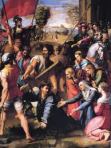 Raphael’s own masterpiece, Christ Bearing the Cross (c. 1516) borrowed
Raphael’s own masterpiece, Christ Bearing the Cross (c. 1516) borrowed 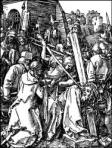 the figure of Christ from Albrecht Durer’s woodcut, Christ Bearing the Cross (1509) from the Small Passion.
the figure of Christ from Albrecht Durer’s woodcut, Christ Bearing the Cross (1509) from the Small Passion. El Greco, the Spanish Mannerist also borrowed from Durer’s Trinity, absorbing outlines and content in his work, The Throne of Grace (1577).
El Greco, the Spanish Mannerist also borrowed from Durer’s Trinity, absorbing outlines and content in his work, The Throne of Grace (1577).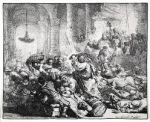 Even Rembrandt, the great Dutch painter and printmaker echoed the figure of Christ in his etching, Christ Driving the Money Changers from the Temple (1638).
Even Rembrandt, the great Dutch painter and printmaker echoed the figure of Christ in his etching, Christ Driving the Money Changers from the Temple (1638). Its design came from the Albrecht Durer woodcut (of the same name) from the Small Passion (1509-1511).
Its design came from the Albrecht Durer woodcut (of the same name) from the Small Passion (1509-1511).

